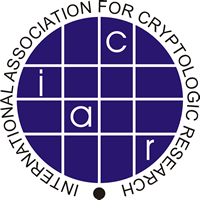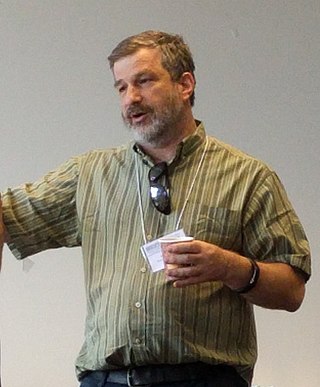
The International Association for Cryptologic Research (IACR) is a non-profit scientific organization that furthers research in cryptology and related fields. The IACR was organized at the initiative of David Chaum at the CRYPTO '82 conference.

David Lee Chaum is an American computer scientist, cryptographer, and inventor. He is known as a pioneer in cryptography and privacy-preserving technologies, and widely recognized as the inventor of digital cash. His 1982 dissertation "Computer Systems Established, Maintained, and Trusted by Mutually Suspicious Groups" is the first known proposal for a blockchain protocol. Complete with the code to implement the protocol, Chaum's dissertation proposed all but one element of the blockchain later detailed in the Bitcoin whitepaper. He has been referred to as "the father of online anonymity", and "the godfather of cryptocurrency".
Ecash was conceived by David Chaum as an anonymous cryptographic electronic money or electronic cash system in 1982. It was realized through his corporation Digicash and used as micropayment system at one US bank from 1995 to 1998.
Cryptologia is a journal in cryptography published six times per year since January 1977. Its remit is all aspects of cryptography, with a special emphasis on historical aspects of the subject. The founding editors were Brian J. Winkel, David Kahn, Louis Kruh, Cipher A. Deavours and Greg Mellen. The current Editor-in-Chief is Craig Bauer.

Serge Vaudenay is a French cryptographer and professor, director of the Communications Systems Section at the École Polytechnique Fédérale de Lausanne
In cryptography, ARIA is a block cipher designed in 2003 by a large group of South Korean researchers. In 2004, the Korean Agency for Technology and Standards selected it as a standard cryptographic technique.

Moni Naor is an Israeli computer scientist, currently a professor at the Weizmann Institute of Science. Naor received his Ph.D. in 1989 at the University of California, Berkeley. His advisor was Manuel Blum.
In cryptography, partitioning cryptanalysis is a form of cryptanalysis for block ciphers. Developed by Carlo Harpes in 1995, the attack is a generalization of linear cryptanalysis. Harpes originally replaced the bit sums of linear cryptanalysis with more general balanced Boolean functions. He demonstrated a toy cipher that exhibits resistance against ordinary linear cryptanalysis but is susceptible to this sort of partitioning cryptanalysis. In its full generality, partitioning cryptanalysis works by dividing the sets of possible plaintexts and ciphertexts into efficiently-computable partitions such that the distribution of ciphertexts is significantly non-uniform when the plaintexts are chosen uniformly from a given block of the partition. Partitioning cryptanalysis has been shown to be more effective than linear cryptanalysis against variants of DES and CRYPTON. A specific partitioning attack called mod n cryptanalysis uses the congruence classes modulo some integer for partitions.
Lattice-based cryptography is the generic term for constructions of cryptographic primitives that involve lattices, either in the construction itself or in the security proof. Lattice-based constructions support important standards of post-quantum cryptography. Unlike more widely used and known public-key schemes such as the RSA, Diffie-Hellman or elliptic-curve cryptosystems — which could, theoretically, be defeated using Shor's algorithm on a quantum computer — some lattice-based constructions appear to be resistant to attack by both classical and quantum computers. Furthermore, many lattice-based constructions are considered to be secure under the assumption that certain well-studied computational lattice problems cannot be solved efficiently.

Cryptography, or cryptology, is the practice and study of techniques for secure communication in the presence of adversarial behavior. More generally, cryptography is about constructing and analyzing protocols that prevent third parties or the public from reading private messages. Modern cryptography exists at the intersection of the disciplines of mathematics, computer science, information security, electrical engineering, digital signal processing, physics, and others. Core concepts related to information security are also central to cryptography. Practical applications of cryptography include electronic commerce, chip-based payment cards, digital currencies, computer passwords, and military communications.
Group-based cryptography is a use of groups to construct cryptographic primitives. A group is a very general algebraic object and most cryptographic schemes use groups in some way. In particular Diffie–Hellman key exchange uses finite cyclic groups. So the term group-based cryptography refers mostly to cryptographic protocols that use infinite non-abelian groups such as a braid group.
Post-quantum cryptography (PQC), sometimes referred to as quantum-proof, quantum-safe, or quantum-resistant, is the development of cryptographic algorithms that are thought to be secure against a cryptanalytic attack by a quantum computer. The problem with popular algorithms currently used in the market is that their security relies on one of three hard mathematical problems: the integer factorization problem, the discrete logarithm problem or the elliptic-curve discrete logarithm problem. All of these problems could be easily solved on a sufficiently powerful quantum computer running Shor's algorithm or even faster and less demanding alternatives.
This article summarizes publicly known attacks against block ciphers and stream ciphers. Note that there are perhaps attacks that are not publicly known, and not all entries may be up to date.
Digital signatures are a means to protect digital information from intentional modification and to authenticate the source of digital information. Public key cryptography provides a rich set of different cryptographic algorithms the create digital signatures. However, the primary public key signatures currently in use will become completely insecure if scientists are ever able to build a moderately sized quantum computer. Post quantum cryptography is a class of cryptographic algorithms designed to be resistant to attack by a quantum cryptography. Several post quantum digital signature algorithms based on hard problems in lattices are being created replace the commonly used RSA and elliptic curve signatures. A subset of these lattice based scheme are based on a problem known as Ring learning with errors. Ring learning with errors based digital signatures are among the post quantum signatures with the smallest public key and signature sizes
In post-quantum cryptography, ring learning with errors (RLWE) is a computational problem which serves as the foundation of new cryptographic algorithms, such as NewHope, designed to protect against cryptanalysis by quantum computers and also to provide the basis for homomorphic encryption. Public-key cryptography relies on construction of mathematical problems that are believed to be hard to solve if no further information is available, but are easy to solve if some information used in the problem construction is known. Some problems of this sort that are currently used in cryptography are at risk of attack if sufficiently large quantum computers can ever be built, so resistant problems are sought. Homomorphic encryption is a form of encryption that allows computation on ciphertext, such as arithmetic on numeric values stored in an encrypted database.
In cryptography, a public key exchange algorithm is a cryptographic algorithm which allows two parties to create and share a secret key, which they can use to encrypt messages between themselves. The ring learning with errors key exchange (RLWE-KEX) is one of a new class of public key exchange algorithms that are designed to be secure against an adversary that possesses a quantum computer. This is important because some public key algorithms in use today will be easily broken by a quantum computer if such computers are implemented. RLWE-KEX is one of a set of post-quantum cryptographic algorithms which are based on the difficulty of solving certain mathematical problems involving lattices. Unlike older lattice based cryptographic algorithms, the RLWE-KEX is provably reducible to a known hard problem in lattices.
Christian Cachin is a Swiss cryptographer and professor of computer science at the University of Bern, Switzerland.
The HAIFA construction is a cryptographic structure used in the design of hash functions. It is one of the modern alternatives to the Merkle–Damgård construction, avoiding its weaknesses like length extension attacks. The construction was designed by Eli Biham and Orr Dunkelman in 2007.
Post-Quantum Cryptography Standardization is a program and competition by NIST to update their standards to include post-quantum cryptography. It was announced at PQCrypto 2016. 23 signature schemes and 59 encryption/KEM schemes were submitted by the initial submission deadline at the end of 2017 of which 69 total were deemed complete and proper and participated in the first round. Seven of these, of which 3 are signature schemes, have advanced to the third round, which was announced on July 22, 2020.
SM9 is a Chinese national cryptography standard for Identity Based Cryptography issued by the Chinese State Cryptographic Authority in March 2016. It is represented by the Chinese National Cryptography Standard (Guomi), GM/T 0044-2016 SM9. The standard contains the following components:




